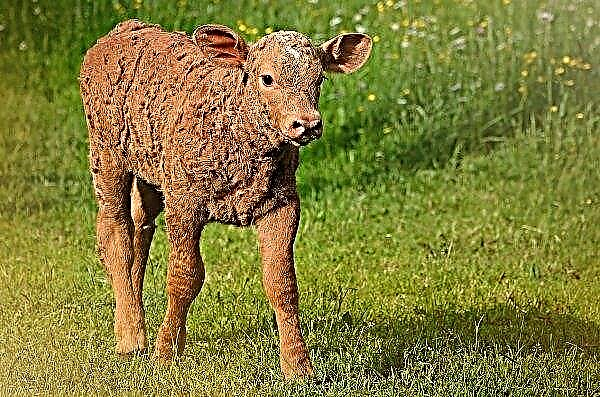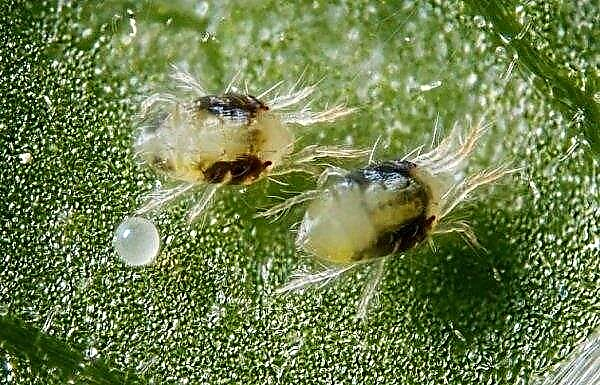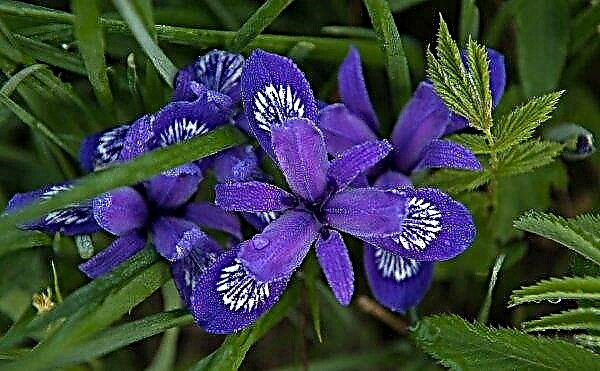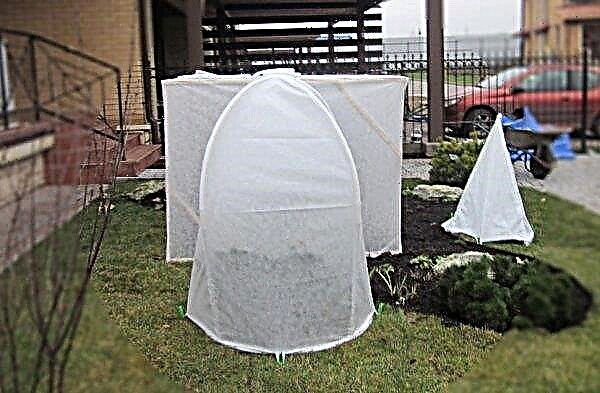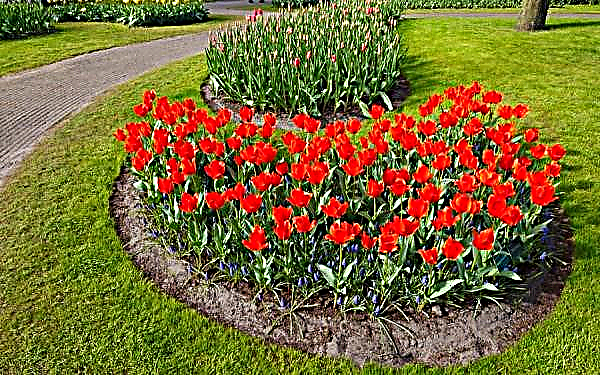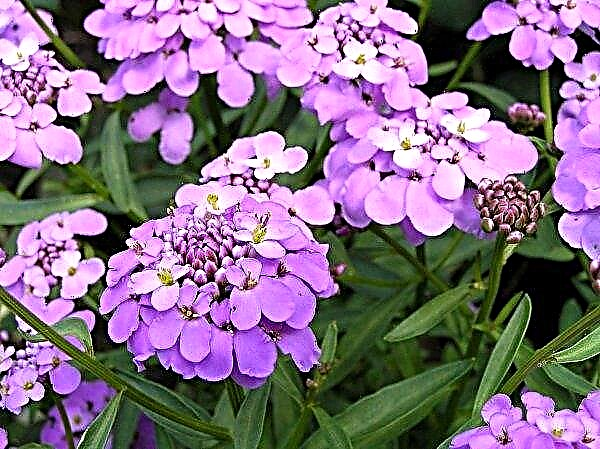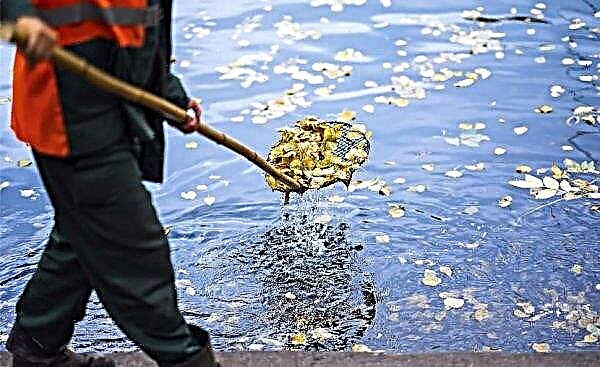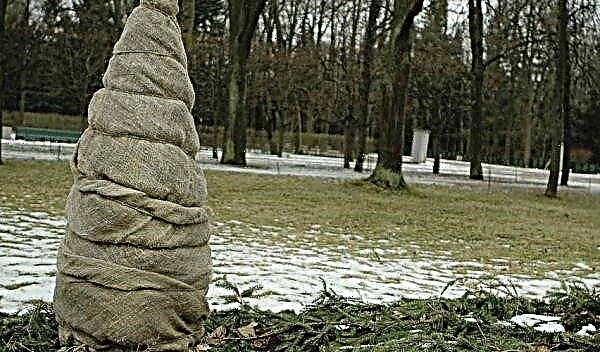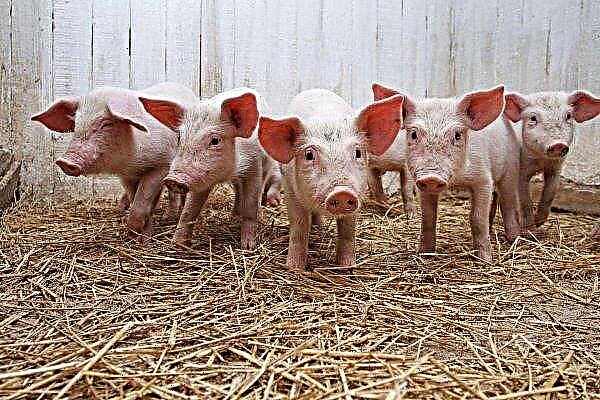Potato Galaxy is a new variety that is excellent for cultivation in regions with a temperate climate. The characteristic features of the plant and growing technology will be discussed below.
History of the variety
The Galaxy potato variety was bred by Irish breeders. The aim of breeding was to develop a new variety with excellent taste and an extended shelf life of tubers. The plant can be grown in Ukraine, Belarus, Moldova, as well as in the central and southwestern regions of Russia.
Botanical description of tubers and bushes
The culture is upright, reaches up to 1.2 m in height. The stems are thickened, ribbed, have a smooth surface, green in color. The lower part of the stem, immersed in the ground, releases long branches up to 30 cm long. Leaf blades are large, cirrus-dissected, their color is dark green.
Did you know? Potato is the first vegetable to be grown in space in 1995 aboard the Columbia ship in the microgravity laboratory.
The flowers are a purple hue with a yellow core. Root crops have a rounded oval shape. Weight reaches up to 100 g. Tubers are cream-colored, with pink eyes and small brown dots. The flesh has a yellow tint; during cooking it becomes friable. The starch content in the root crop is 18%.
Grade characteristics
Potato is a perennial herbaceous plant in the genus Solanaceae. The culture is unpretentious in leaving, therefore, even in its absence, gives good results.

Disease immunity
The Galaxy potato variety has excellent immunity to the most common fungal infections that affect the culture, such as late blight, alternariosis, rhizoctonia, and is also resistant to bacterial cancer.
The variety has average scab resistance. The culture is resistant to the potato nematode, which provokes the spread of infectious diseases and spoils the crop.
Ripening dates and productivity
The crop has an average ripening period, the crop can be harvested 90 days after planting in the ground. Productivity from one bush will be up to 15 pieces of root crops. From 1 ha of plantings, you can collect up to 250 centners of potatoes.
Plus qualities and possible disadvantages of the variety
- Among the advantages of the Galaxy variety, we can distinguish: s
- resistance to fungal infections;
- tuber pulp is not subject to darkening during heat treatment;
- consistently high yields.
The minus of the culture is that at the time of harvesting the leaves the tops do not have time to dry - this leads to a difficulty in the process of digging tubers.

Agricultural technology planting potatoes
Growing potatoes is a simple process. If you adhere to some planting rules, you can easily get high yields.
The right time to land
Landing work is carried out in mid-May. The air temperature should warm up to + 23 ° C.
Site selection and soil preparation
In order for the roots located on the tubers to grow, the soil temperature must be at least + 10 ° C. On sandy soils, potatoes are planted to a depth of 20 cm, on heavy soils - by 15 cm.
Important! If you plant the potatoes too deep, the crop will be small due to lack of nutrients.
For planting potatoes, it is necessary to choose a spacious area, with good lighting and the absence of draft, which will contribute to the spread of pests and fungal spores in the wind. The depth of groundwater in the area should be at least 1.5 m, so that excess moisture does not interfere with the development of root crops.

If it is not possible to change the place for planting every year, in the autumn after harvest, the territory is sown with siderat plants, such as legumes, grass, winter crops, cucumbers, they are the best predecessors for sowing potatoes.
In temperate regions, it is more advisable to use winter crops or grass, because cucumbers do not have time to ripen, you can also simply fertilize the soil with manure in the autumn. Preparation of soil for planting begins in the fall. If it is possible to change the location of the potato planting, it will be better. You need to remove all weeds, leftovers and other garbage on the site.
The soil is dug up 30–40 cm in depth, while fertilizing in the form of manure in the amount of 5 kg per m² is applied, 300 g of wood ash per m² are also applied, which will help eliminate soil acidity and protect future plantings from pests.
Preparing tubers for planting
For planting, tubers of medium size are chosen, they should be without rot and diaper rash. 2 weeks before the intended planting, seed potatoes are placed in a plastic bag, in which several holes are made for air intake. Potatoes with overgrown roots of 3 to 5 cm are suitable for planting; they must be powerful and strong.
 Immediately before planting, the tubers are immersed in a weak pink solution of manganese for 40 minutes to disinfect.
Immediately before planting, the tubers are immersed in a weak pink solution of manganese for 40 minutes to disinfect.
Scheme and depth of landing
In the spring, a month before planting, you need to dig the soil. The scheme of planting potatoes in the ground: 70 cm between rows and 40 cm between bushes. This planting scheme will allow you to easily care for plants, and will also contribute to the growth of tubers.
The holes are dug to a depth of 20 cm, 100 g of chicken droppings are put on the bottom as fertilizer. Then planting material is laid out and buried with earth, forming a small mound on top.

Features of further care
Watering the crop should be as necessary, taking into account the precipitation. It is necessary to ensure that the soil does not dry out during the flowering period. Watering is carried out for the first time during active growth, on the 10th day after germination, 5-7 liters of water are applied to each bush. The second watering should be carried out in the flowering phase, and the third - 21 days before digging the crop.
During the period of potato growth, the hilling procedure is carried out three times:
- after the appearance of strong shoots 10 cm high, they are sprinkled with 6 cm soil, which will protect the plants from possible frosts;
- the next hilling is carried out when the sprout reaches 20 cm in height;
- the last time the embankment is formed during flowering.
Important! Loosening of the soil is carried out after each irrigation and rain, the depth of weeding should be at least 10 cm, which will avoid the formation of a hard crust on the soil surface. The higher the humidity level, the deeper the loosening should be carried out.
In order to get a rich harvest, you need to fertilize the crop 3 times a season.
Feeding:
- The first fertilizer is carried out when the tops reach 10 cm. About 500 ml of liquid mullein will be needed on the bush. It is carried out after watering or rain.
- The second top dressing should be done at the time of budding. For digging make 200 g of wood ash on each bush.
- During the flowering period, the third fertilizer is applied, which is necessary for the rapid growth of the rhizome. A glass of mullein and 60 g of superphosphate are added to 10 liters of water.

In order to grow potatoes, it is also necessary to regularly combat pests and diseases that can affect tubers and the aerial part of the plant. The most dangerous pest for culture is the Colorado potato beetle, which eats leaves and flower ovaries.
The danger of the beetle lies in its extreme voracity and fertility. The offspring of one pair of Colorado beetles can destroy up to 4 hectares of crops.
Read more

- Manual cleaning of insects and their destruction.
- Clipping leaves on which offspring were laid.
- Regular loosening of the soil, near the bush.
- Irrigation of culture with the preparation "Karbofos" 90 g per 10 liters.
Since the variety has average scab resistance, you need to know how to deal with it. Scab affects the peel of the vegetable, forming warty growths on it. The disease can spoil up to 50% of the crop.
Fight with the scab:
- On soils infected with scab, the fungicide "Maxim" 4 ml per 1 liter of water is used. The drug is sprayed with tubers before planting in the ground.
- Irrigation of the aerial part 3 times a season with the Fitosporin preparation 1 package of the product is diluted with 3 liters of water.

Prevention of diseases and pests:
- careful selection of planting material;
- selection of resistant varieties;
- annual change of landing place;
- so that root crops do not undergo scab, 10 days before digging, you need to mow the tops;
- regular weed harvesting and soil loosening.
Harvesting and storage
To determine the readiness of tubers for harvesting, it is necessary to focus on the appearance of the aerial parts of the plant, if it begins to fade or turn yellow, then you can harvest. First you need to dig one bush to make sure the vegetables are ripe, their dense peel means that you can proceed to the collection.
Did you know? During the "gold rush" of 1897-1898 in Alaska, potatoes were worth its weight in gold, because it was the only salvation from scurvy for people who went in search of gold mines.
After digging, the vegetables are left in the open air, preferably under sunlight for 2 hours, and then sorted and placed in prepared boxes. More than 2 hours, you can’t keep the potatoes in the sun, because under its influence the production of toxic substances begins in the product. During the first month, after harvesting, the potatoes are kept in crates in a warm, dark room.

Little by little, the temperature for storing vegetables is reduced to + 3 ° C. After 4 weeks, the root crops are again sorted and discarded unsuitable. After selection, the vegetables are lowered into the cellar for the winter. Root crops should be stored at humidity up to 80%. Vegetables can be in the cellar for up to 7 months, they are little susceptible to damage, so they are perfectly transported over long distances and do not deteriorate on the road.
Potato Galaxy is a new variety that vegetable growers need to focus on. The culture is resistant to fungal infections, unpretentious in care, which makes it attractive to grow.

